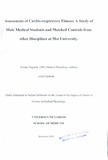| dc.description.abstract | Cardio-respiratory fitness (CF) is crucial to health among all age groups and high levels are attained following involvement in physical activity (PA). Its assessment involves measurement of physiological markers like heart rate (HR) and maximum oxygen uptake ( Vo2max). A Vo2max below 44 mVkg/min in young adult males may lead to compromised health. Higher values are indicative of more favourable CF. The current descriptive cross sectional study aimed to compare CF among male university students based on their year of study, past exercise history and assumed knowledge of benefits of CF.
Forty (40) male students aged 18-25 years were randomly selected from the School of Medicine, with matched controls selected from other schools within Moi University. Upon filling a questionnaire on past P A and exercise, and passing a full physical examination, baseline cardio-respiratory functions of HR, blood pressure (BP) and lung function tests were measured. The HR was also assessed during the 20 m shuttle run test (SRT) and, together with BP, further measured at exhaustion and for the first five minutes during abscissa. The V02max was determined using beep test score calculator developed by Ramsbottom et al. (1988).
Stata V 9 was used for analysis. First year students from all programs had significantly higher W2max compared to their fourth year colleagues (44.7ᄆ4.8 vs 40.3ᄆ5.3 mllkg/min, p<O.OOl). In addition, they had lower diastolic blood pressure (DBP) at exhaustion from SRT when compared to fourth years (57.3ᄆ13.3 vs 64.6ᄆ12.7 mmHg, p=O.Ol). Predictors of Vo2max included year of study, age, weight, baseline respiratory rate and HR, all showing negative correlations.
Others included HR after first and second minutes into SRT, and DBP and HR after first and fifth minutes of rest respectively. There were positive correlations between Vo2max and tidal and inspiratory reserve volumes (r = 0.37, p<O.()'1 and r = 0.45; p<O.OOI respectively) as well as the vital capacity (r = 0.49, p<O.OOI). Students who exercised, regardless of the regularity, had higher V<:hmax compared to their sedentary colleagues (43.4ᄆ5.4 vs 38.6ᄆ4.l ml/kg/min (p<O.OI). They also had lower HR during 3rd to 6th minute of exertion in SRT, which was further evident after 5th minute of rest. Students who exercised regularly attained higher V<hmax (45.1ᄆ4.7 vs 41.0ᄆ5.5 ml/kg/min, p=O.002) than the less regular. Overall, the students had below average fitness irrespective of their course of study.
Fourth year students were less physically fit compared to their first year counterparts. Regardless of the frequency, students who exercised had lower HR in 3rd to 6th minute of SRT, and achieved higher V02max portraying that they were fitter than their sedentary counterparts. Likewise, students who exercised regularly had higher V<:>2max compared to their colleagues. There is need to encourage regular exercise regimes among university students. This is especially so for higher level students. Additionally, further research is needed to show how males compare with female in the same settings. | en_US |

